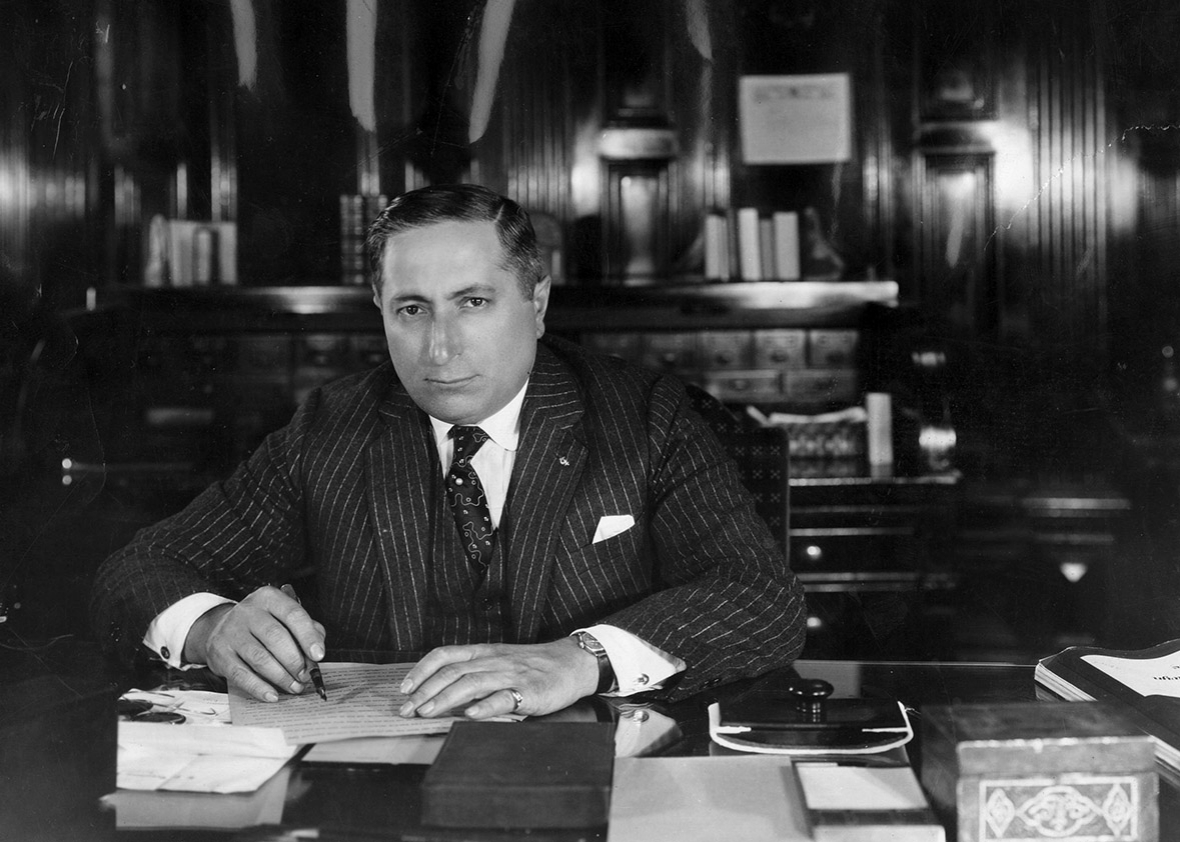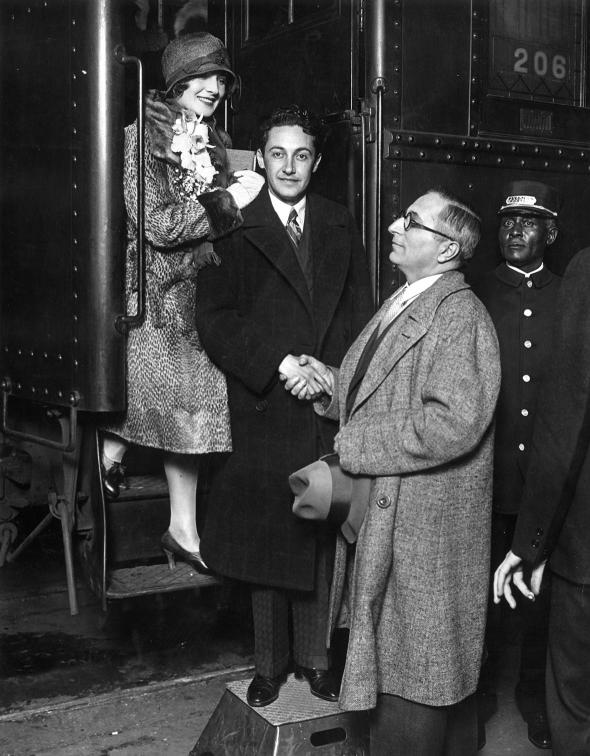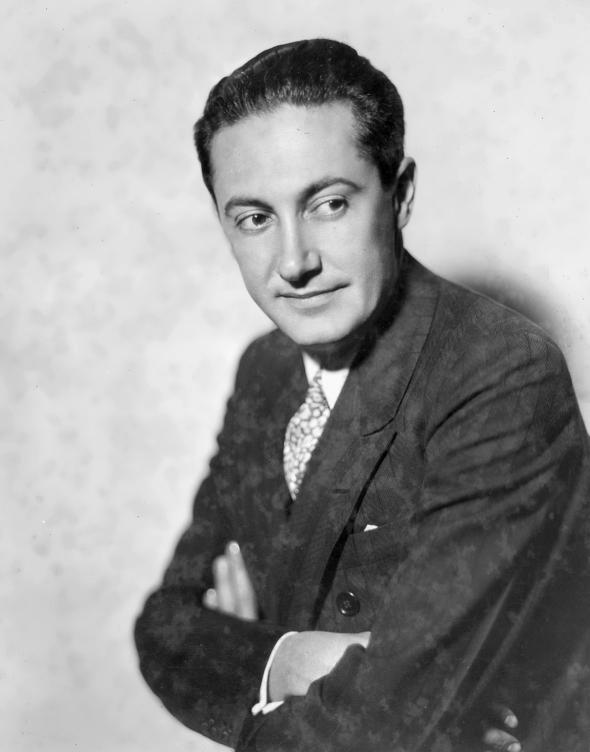The Boy Genius and the “Jewish Hitler”
Irving Thalberg and Louis B. Mayer, the tumultuous pair at the center of MGM’s box-office supremacy.

Photo by General Photographic Agency/Getty Images
This week, the new season of You Must Remember This, the podcast that tells the secret and forgotten history of 20th-century Hollywood, makes its debut on Panoply. And when each episode airs, creator and host Karina Longworth will share some of the research that went into the episode in a transcript excerpt here on Slate. Listen to the complete Episode 1 below, and subscribe to You Must Remember This on iTunes.
When Louis B. Mayer was 19, he moved from Canada to Boston, and three years later—by which point he was married and the father to two daughters—he bought a local burlesque theater and turned it into a movie house. This led to owning a chain of theaters throughout New England. Mayer made the beginnings of a fortune from the profits on his exclusive regional run of D.W. Griffith’s The Birth of a Nation. As he later remembered, “I pawned everything I owned—my house, my insurance, even my wife’s wedding ring—just to get the New England states’ rights. Since then, everything’s been very pleasant.”
As a theater owner, Mayer had seen a direct correlation between correctly packaged high-quality stars and big profits. In 1918, Mayer moved his family to Los Angeles, where Louis B. Mayer Productions set up shop in half of a studio on Mission Road in East L.A. and started assembling a roster of stars. Most of Mayer’s initial stars were newcomers in whom he saw something special, like a 21-year-old woman with a slightly lazy eye named Norma Shearer.
In a time when other independent producers made their bones exploiting fads or promising titillation, and when the local and national newspapers were milking a wave of sex and drug scandals among the Hollywood elite for more than they were worth, Mayer remained steadfastly moral and moralistic. The more the media harped on the Fatty Arbuckle rape allegations or Wallace Reid’s heroin problem, the more Mayer was convinced that angry Christian mobs would eventually rise up and burn Hollywood to the ground. “If this keeps up, there won’t be any more film business,” he said.
Mayer’s personal morals would later come to infuse the kinds of movies that MGM made. He believed that movies should represent “family values,” that they should show viewers a better, idealized way of American life and American manhood—and that this kind of nonsexual vicarious pleasure should be enough. “I don’t care what DeMille does, with his naked slave girls,” Mayer once said, referring to the master of period film spectacle. “No Mayer picture will have bedroom scenes, even where couples are married.”
By the early 1920s, Mayer was looking to expand. At Paramount, they were making movies on an assembly-line model—as soon as one production vacated a stage, another was ready to move in. Mayer figured more movies meant more profits, but he needed more staff to make it happen. In November 1922, Mayer invited Irving Thalberg to meet with him at his studio.
Thalberg was known around town as a boy genius. At age 23, he had already been running production at Universal Studios for years. He was bored there, and frustrated that his bosses were always trying to cut back. That wasn’t Mayer’s style—Mayer believed in spending money to make money. Mayer, ever big on cinema as a mechanism for imagining an idealized self, saw in Thalberg something that he wanted to be. Thalberg was classy. And he liked making classy pictures, based on literature. After their meeting, Mayer called Thalberg’s lawyer and said, “Tell him if he comes to work for me, I’ll look after him like my own son.” In February 1923, Thalberg and Mayer officially joined forces. Thalberg quickly became part of the fabric of the place, wooing and marrying Mayer’s contract ingénue, Norma Shearer.

Photo by Hulton Archive/Getty Images
Mayer—called “L.B.” or “Louie B” by his friends and epithets like “Jewish Hitler” by his enemies—was the self-styled bad cop in the executive partnership: He handled the money stuff, he did the firing, he delivered most of the bad news. “Just be charming, Irving,” he once told his partner. “I’ll be the prick.” By 1924 the pair had teamed with Marcus Loews’ Metro Pictures and Goldwyn Pictures, which had a studio lot that needed tending, and Metro-Goldwyn-Mayer was born.
Over the next 10 years, as the silent era faded away and sound film came in and gradually became more sophisticated, every studio in town would establish a house style, often tied to its mastery of a specific genre. Warner Bros. would become known for movies about and for the working classes, often involving gangsters. Paramount, home of sophisticated stars such as Claudette Colbert and Marlene Dietrich, produced at two poles—B-movies for the plebes and sophisticated special productions shot on big white sets for a specialized audience. MGM tried to reduce the space in between those poles, to neither talk down to a presumably uneducated audience, nor flatter the higher echelon of the audience with tony entertainments that bored the common man to death. They didn’t take a lot of risks, and they were careful not to offend. The goal was to make movies that everybody wanted to see.
The outside perception of MGM was that it was the studio where stars ruled—and they were the lure that secured the audience—but they weren’t generating their own material or making choices about how to ensure career longevity. Much of that was the work of Thalberg. MGM was always conservatively politically minded, but the labor on MGM films was often collective. Thalberg regularly cobbled together screenplays from the efforts of a team of writers, not unlike the contemporary television writers room, but very unlike what was common at other studios in the 1930s. One thing MGM definitely was not was a studio friendly to auteur directors. Both Mayer and Thalberg were attracted to unpretentious efficiency. They respected directorial talent—that’s why they let Erich von Stroheim finish out his contract, even after he delivered a 10-hour cut of Greed that the studio deemed unreleasable. And with his next film, The Merry Widow, Von Stroheim scored a massive hit. But no director at MGM was indispensable.

Photo by Hulton Archive/Getty Images
Thanks to the grosses of massive silent hits like The Big Parade, The Merry Widow, and Ben-Hur, MGM boldly staked a claim for the studio and its style of filmmaking in its first year. These successes proved to the industry—and maybe more importantly, to the internal power structure—that Mayer and Thalberg’s way of doing things worked. For both men, preserving the MGM way became of paramount importance. That was one of the reasons why, in January 1927, Mayer spearheaded the formation of the Academy of Motion Picture Arts and Sciences, paying out of his own pocket to host the academy’s first dinner party at the Biltmore ballroom, where 36 industry leaders met and discussed the goals of their organization. At first, the academy existed to present a unified front among the studios and town power-brokers on the questions of the day, such as standardization issues regarding the emerging sound technologies and the increasing threat of unionization among the various factions of filmmakers. With the academy strengthening each individual studio’s bargaining muscles, the industry leaders were able to temporarily prevent widespread unionization.
The Oscars came later—nearly 2½ years later, the first awards ceremony not held until May 1929. By this point, Mayer had decided that using his power to net his filmmakers trophies was a good way to make them grateful to be at MGM, and thus make them more willing to make movies the MGM way. The first Oscars weren’t balloted so much as negotiated upon by some of the most powerful people in late 1920s Hollywood—including Mary Pickford, Douglas Fairbanks, Sid Grauman, and Mayer. Grauman, who owned a chain of movie theaters, supported King Vidor’s The Crowd for best picture. The Crowd was an MGM movie, but it was one of Thalberg’s pet productions, and Mayer hated it—he thought it was both pretentious and vulgar, disparaging Vidor for insisting on including a shot of a toilet. Mayer refused to support his own studio’s movie, so the first Best Picture Oscar went to the Clara Bow fighter pilot movie Wings.
To the general public, Mayer was among the most famous of studio heads, and within Hollywood, other moguls resented and envied him. But within his own family, Mayer was the redheaded stepchild. Mayer felt uncool and uncouth compared with Thalberg, and the slightest perceived slight from his supposed partner could reduce Mayer to tears.
For his part, Thalberg was exhausted and starting to feel like all the hard work wasn’t worth it. As early as September 1932, he asked the rest of the MGM brass to grant him a year’s leave of absence. “I don’t feel well,” he said. “The responsibility is too great. I would like to go away and come back and then see what I want to do.” But Thalberg was under contract until 1937, and the parent company was not about to let him off the hook, threatening to sue. So Thalberg went back to work—but now he was certain that the other powerful men at the studio, including Mayer, were actively against him.
At Christmas 1932, Thalberg came down with the flu. Three days later, he began suffering from chest pains, which were later confirmed to be a heart attack. Thalberg now had a doctor’s orders to back him up: He was going to take six months and go to a heart clinic in Germany. How would it look for the studio’s professed “family values” ethos if the MGM power circle tried to stop him now?
His very real health problems aside, Thalberg must have known that if he was going to leave work for six months, MGM would need to replace him, at least temporarily. And Mayer et al must have been concerned that there was a possibility that Thalberg wouldn’t come back at all. Still, Mayer’s approach to finding a fill-in for Thalberg was seen by some as unseemly. After Thalberg announced his planned six-month leave of absence, Mayer signed David O. Selznick to a two-year contract. Selznick had spent two years as the head of production at RKO, where he had helped to launch the careers of both George Cukor and Katharine Hepburn with the film A Bill of Divorcement; he helped to enshrine Hollywood’s favorite myth about itself with the A Star Is Born precursor What Price Hollywood?, and with the original King Kong, he helped to invent the future. Selznick was 30, he was hungry, and his résumé, though short, was solid. He was a good hire. He was also Mayer’s son-in-law, having married Mayer’s daughter Irene three years earlier.
“More than any single person in Hollywood,” Thalberg once said, “I have my finger on the pulse of America.” But Thalberg should have known better—he himself had helped to create MGM as a place that was unfriendly to auteurs, where movies were made by committee. His certainty that he alone knew what was best for MGM, and his unwillingness to cede his vision to the larger machine, would aid the corporate office’s attempt to marginalize him. When Thalberg returned from Europe in August 1933, MGM gave him his own production unit. Thalberg would have his own bungalow on the studio lot, his own budgets, his pick of the best stars in the studio’s stable, minimal supervision from the suits above—and no real say in how the studio was run as a whole. In essence, Mayer had won, consolidating power in his own house—by bringing in his son-in-law to replace a man he had once promised to treat as a son.